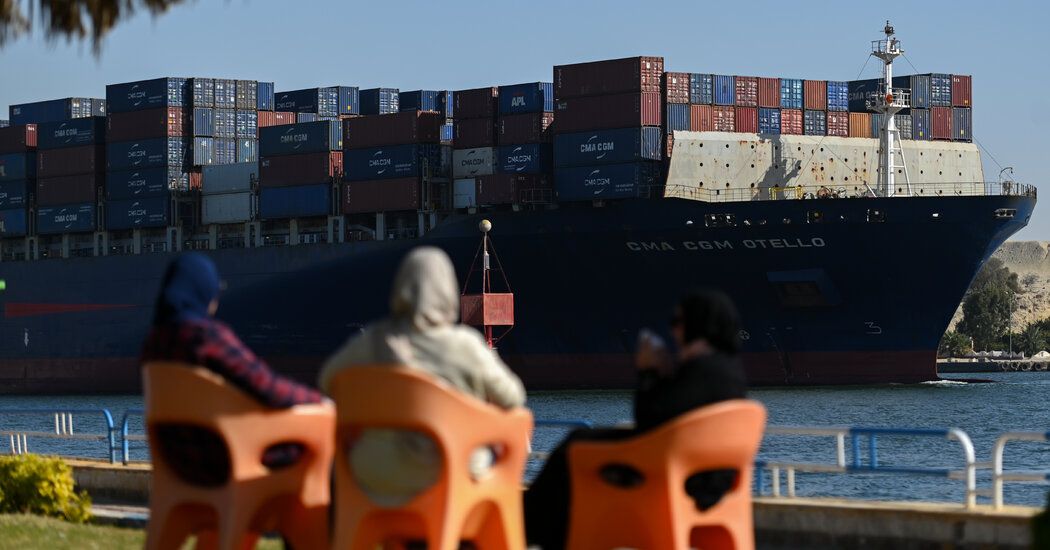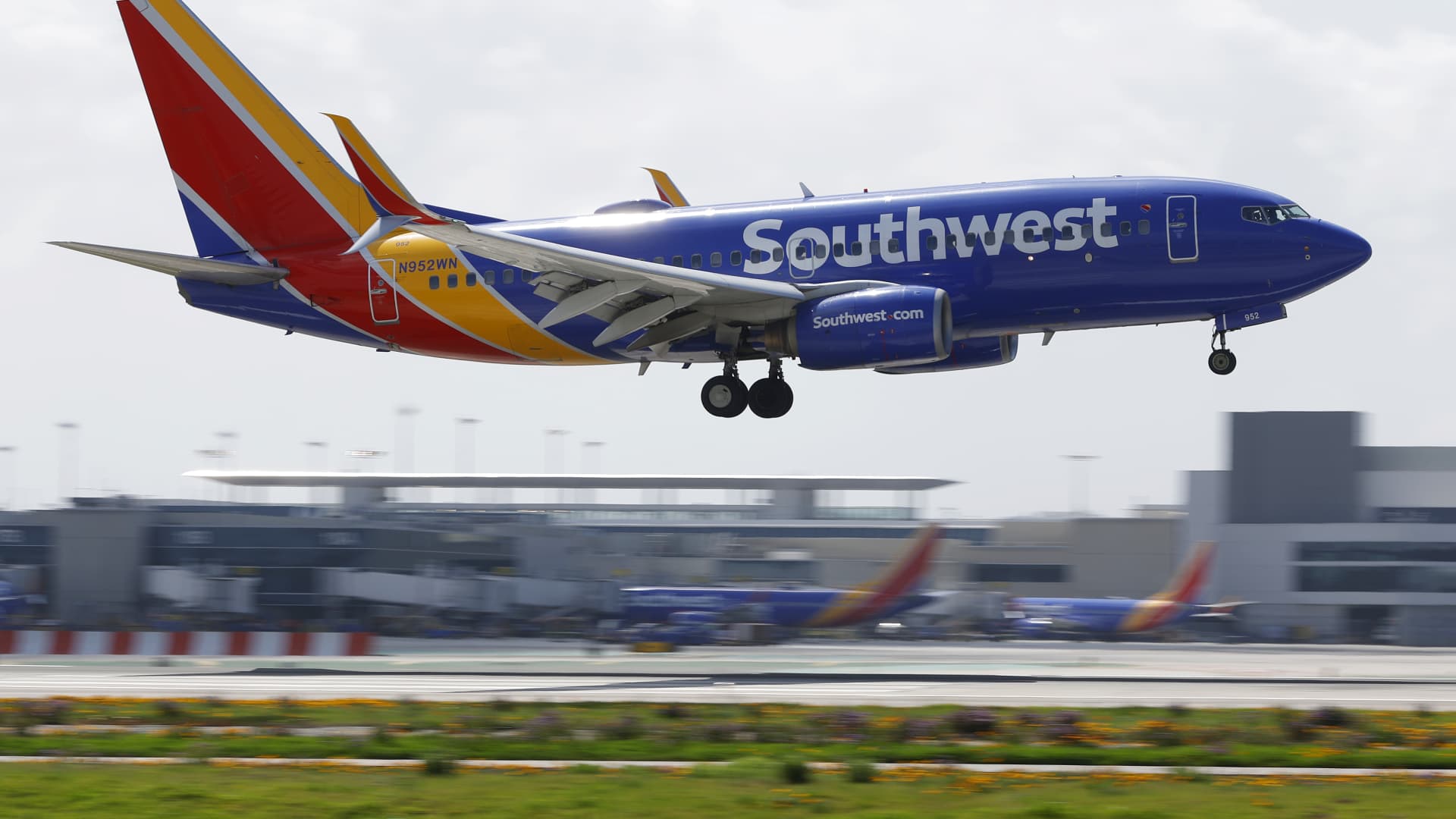For about two months, a barrage of missile and drone attacks in the Red Sea by Houthi militants has posed a difficult choice for shippers using the Suez Canal: risk an airstrike and pay much higher insurance rates. , or give up the canal and take the long way around. route around Africa, with complicated schedules and higher fuel costs.
The attacks, in a choke point that handles 12 percent of global trade, including nearly a third of global container ship traffic, have already forced some closures at European auto plants and raised fears of a rise in consumer prices.
For shipping companies, costs have already increased. A composite measure of global shipping costs, the Drewry World Container Index, has more than doubled since the end of last year. The increase is partly related to a shortage of empty shipping containers, caused by the additional time of up to two weeks for voyages around the Cape of Good Hope in Africa.
And using the Red Sea now requires expensive war risk insurance. It is a specialty offered by a group of brokers and insurers based in London.
“We are not fair weather insurers,” said Munro Anderson, chief operating officer of Vessel Protect, a maritime war risk insurance firm. “We are there for our clients when things get tough,” he added.
War risk cover is often required for vessels heading into areas designated as high risk by a group of insurers called the Joint War Committee, which is made up of insurers from Lloyds and other organisations. War risk is “an area of business where, generally speaking, if the insurance community does it well, they make money from it,” said Marcus Baker, global head of shipping, cargo and logistics at Marsh, an insurer in London.
But the cost of insuring container ships or oil tankers transiting the Bab al-Mandeb Strait off Yemen en route to Suez has soared in recent weeks.
Maritime war risk premiums have increased fifty-fold since before the war, reaching 1 percent of the ship's value, although around 0.7 percent appears to be more common. For a ship carrying $100 million worth of goods, that means an additional $700,000 during the few days needed to traverse the Red Sea area.
Baker said war risk rates for the Red Sea were less exorbitant than those for shipping in the Black Sea from Ukraine, which can be as high as 3 percent. One reason for the difference: The environment is considered more hostile because Russia is a more dangerous attacker than the Houthis. So far, insurers say, the Houthi attacks, while intimidating, have caused relatively little damage.
Some insurers also insist that clients include clauses in their contracts ensuring that they have no connection with Israel, whose military campaign in Gaza is the reason the Houthis give for their attacks, or with the United States and Britain, which have launched planes and missiles. attacks against the Yemen-based group. In an effort to protect against attacks, a growing number of ships have broadcast messages such as “No contact with Israel,” according to TankerTrackers, a tracking service.
The U.S.-led multinational naval task force to protect commercial vessels in both the Red Sea and the Gulf of Aden has so far not helped reduce insurance costs, brokers say, although rates may be stabilizing. . Israel has offered to compensate the shipowners for any damage suffered in Israeli waters.
But for the moment, most of the giant ships bringing stacks of containers to Western ports from China are taking the African route, which could require an extra two weeks with higher fuel costs. During a recent 30-day period, 517 container ships left the Red Sea around the Cape of Good Hope, while 212 continued through the Suez Canal, said Jonathan Roach, who tracks container shipping for Braemar, a shipping corridor. London ships. In November, he said, the proportion was more or less the reverse.
Tankers carrying oil and liquefied natural gas around the world are also increasingly avoiding the Suez Canal. Even LNG tankers from Qatar, a major gas supplier to Europe whose vessels had been considered protected from Houthi attacks because the emirate had hosted Hamas leaders, are now sailing around Africa, Kpler analyst Laura Page said. that tracks maritime transport.
Over time, more tankers may choose the longer route. “There will be a point at which the pain and cost of entering the Red Sea and passing through the Suez Canal outweigh the simple economics of going around the Cape,” said Lois Zabrocky, chief executive of International Seaways, an oil and products owner and operator. chemicals. oil tankers, she said at an investor event last week. “And this is an ever-evolving situation.”
Still, energy prices have been subdued, reflecting weakening demand and rising production in the United States and elsewhere, with Brent crude below its level on Oct. 7, the day Hamas attacked Israel. Even as tanker rates have risen about 25 percent since the Red Sea disruptions began, according to Goldman Sachs, European natural gas prices have remained low, likely due to large quantities of fuel in storage. and to alternative supplies from the United States.
CMA CGM, a Marseille-based company and one of the world's largest container shippers, sends some ships through the Suez Canal, sometimes escorted by the French Navy. Analysts say the ships still sailing through the Suez tend to be older, smaller vessels that would mean smaller losses if they were hit.
It is unclear whether rising shipping costs will be reflected in consumer prices, especially in Europe, where economies are barely growing. Weak consumer demand means companies will face pressure to absorb additional shipping costs into their profit margins “rather than passing price increases on to consumers,” Morgan Stanley analysts said this week.
One factor easing the current crisis is the excess of cargo ships and containers. After the severe shipping jams of 2022, logistics companies ordered large quantities of ships and containers that are now helping to alleviate the global crisis in the movement of goods.
The longer shipping routes resulting from avoiding the Red Sea are actually helping the market absorb what would have been a substantial oversupply of vessels, at least temporarily easing pressure on companies to scrap surplus vessels, Braemar's Roach said. . “Maybe it's not a bad time for this situation to happen,” he said.
Despite this ample supply of ships and containers, hostilities in the Red Sea have caused freight costs to skyrocket. Roach said it would likely take another three to four months or more of disruption in the Red Sea for prices to match their 2022 peak.
Christian Roeloffs, chief executive of Container xChange, a Hamburg, Germany, company that operates a marketplace for shipping containers, said box prices were rising because the sudden extension of sea travel had surprised the industry with inventories of boxes in wrong places. places.
Importers rushing to stock up on orders from Chinese factories before they close for the upcoming Lunar New Year holiday are also causing a scramble for containers, he said.
“While the capability exists in theory, it cannot be deployed that quickly,” Roeloffs said. He predicted that the holiday period in China next month would give shippers time to recover. “We will really see a normalization,” he said.
Jenny Gross contributed with reports.








